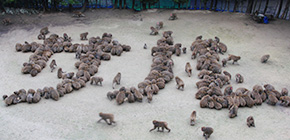
Awajishima macaques: High social tolerance produces cooperative society
A group of researchers from Osaka University Graduate School of Human Sciences clarified that Japanese macaques ( Macaca fuscata ) were able to achieve cooperative tasks that could not be achieved alone.
It has been revealed that individual differences and species differences in level of tolerance have a great impact on the occurrence of cooperative behavior in animals. For example, chimpanzee dyads that are more likely to share food perform better in solving cooperative tasks. Bonobos ( Pan paniscus ), the dwarf or gracile chimpanzees, feed with conspecifics more peacefully than chimpanzees and cooperate much better in cooperative tasks when rewards are highly monopolizable.
Since it is thought that Japanese macaques have a low level of social tolerance, no studies on their cooperative tasks had been conducted. However, recent studies showed that Japanese macaques exhibit regional differences in their levels of tolerance. Focusing on regional differences in tolerance of wild Japanese macaques, this group demonstrated that Japanese macaques were able to solve cooperative tasks with peers.
Generally speaking, Japanese macaques form societies with strict hierarchy. Since a high-ranking monkey monopolizes food by pushing away subordinate monkeys, it was thought that Japanese macaques would not engage in food collection together. However, the Japanese macaque group inhabiting Awaji Island, Japan (the Awajishima group), has a high level of tolerance, with monkeys of different rankings able to share food.
In this study, the researchers performed cooperative behavior experiments among the Awajishima group, with its high level of tolerance, and the Katsuyama group, with a low level of tolerance. In experiments, two macaques obtained food rewards by pulling both ends of a single rope. As a monkey cannot pull both ends of the rope by himself, two macaques need to pull the rope simultaneously in order to obtain food rewards. In the Awajishima monkey group, macaques frequently solved the cooperative task. When there was no partner to cooperate in the vicinity, they waited until a partner came without pulling the string.
Although it is thought that Japanese macaques’ intellectual level is high enough to perform cooperative tasks, individuals in the Katsuyama group avoided each other and had few opportunities for cooperation. From this, not only high intelligence, but also a high level of tolerance, is a prerequisite for cooperation to occur in society. It is considered that an increase in social tolerance was generated by a decrease in aggressiveness in human evolution. Research on cooperative behavior in the Awajishima group provides powerful support to the evolutionary theories of human cooperation.

Figure 1
The Awajishima group eats food nicely in formation of the word “saru,” meaning “monkey(s)” in Japanese. As Japanese macaques usually fight over food, which is monopolized by dominant groups, no letters can be formed.

Figure 2

Figure 3
The article, "High but not low tolerance populations of Japanese macaques solve a novel cooperative task," was published in Primates at DOI: https://doi.org/10.1007/s10329-019-00742-z .
Graduate School of Human Sciences, Osaka University (link in Japanese)
